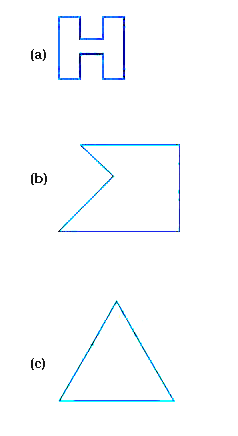If a rectangle has more than two lines of symmetry, then it must be a square.
To determine if the statement "If a rectangle has more than two lines of symmetry, then it must be a square" is true, we can follow these steps:
1. Understanding Lines of Symmetry:
- A line of symmetry is a line that divides a shape into two identical halves that are mirror images of each other.
2. Lines of Symmetry in a Rectangle:
- A rectangle has exactly two lines of symmetry. These are:
- One vertical line that divides the rectangle into two equal halves.
- One horizontal line that also divides the rectangle into two equal halves.
3. Lines of Symmetry in a Square:
- A square has four lines of symmetry. These are:
- Two lines that are vertical and horizontal (like the rectangle).
- Two diagonal lines that run from corner to corner.
4. Comparing Rectangles and Squares:
- Since a rectangle has only two lines of symmetry, it cannot have more than two lines of symmetry.
- A square, however, has four lines of symmetry.
5. Conclusion:
- Therefore, if a rectangle has more than two lines of symmetry, it cannot be a rectangle; it must be a square because only a square has more than two lines of symmetry among quadrilaterals.
Final Statement:
The statement "If a rectangle has more than two lines of symmetry, then it must be a square" is true.
- A line of symmetry is a line that divides a shape into two identical halves that are mirror images of each other.
- A rectangle has exactly two lines of symmetry. These are:
- One vertical line that divides the rectangle into two equal halves.
- One horizontal line that also divides the rectangle into two equal halves.
- A square has four lines of symmetry. These are:
- Two lines that are vertical and horizontal (like the rectangle).
- Two diagonal lines that run from corner to corner.
- Since a rectangle has only two lines of symmetry, it cannot have more than two lines of symmetry.
- A square, however, has four lines of symmetry.
- Therefore, if a rectangle has more than two lines of symmetry, it cannot be a rectangle; it must be a square because only a square has more than two lines of symmetry among quadrilaterals.
The statement "If a rectangle has more than two lines of symmetry, then it must be a square" is true.
Topper's Solved these Questions
- SYMMETRY AND PRACTICAL GEOMETRY BOOK - NCERT EXEMPLARCHAPTER - SYMMETRY AND PRACTICAL GEOMETRY EXERCISE - Exercise
29 Videos
- SYMMETRY AND PRACTICAL GEOMETRY BOOK - NCERT EXEMPLARCHAPTER - SYMMETRY AND PRACTICAL GEOMETRY EXERCISE - Exercise (In questions 18 to 42, fill in the blanks to make the statements true.)
25 Videos
- RATIO AND PROPORTIONBOOK - NCERT EXEMPLARCHAPTER - RATIO AND PROPORTIONEXERCISE - Exercise (In questions 35 to 46, fill in the blanks to make the statements true.)
11 Videos
Similar Questions
Knowledge Check
Which of the following has more than two lines of symmetry
AEquilateral triangleBParallelogramCRectangleDNone of theseA square has how many lines of symmetry
Aone line of symmetryBtwo lines of symmetryCthree lines of symmetryDfour lines of symmetryWhich of these has only two lines of symmetry?
AHBBCVDS
A kite has two lines of symmetry.
View SolutionIf an isosceles triangle has more than one line of symmetry, then it need not be an equilateral triangle.
View SolutionDraw all lines of symmetry, if it has.

View SolutionLines of symmetry of a square
View SolutionA regular pentagon has no lines of symmetry.
View Solution
